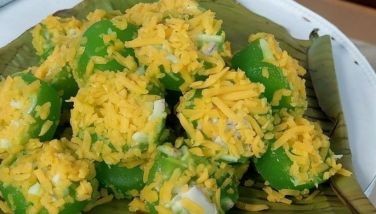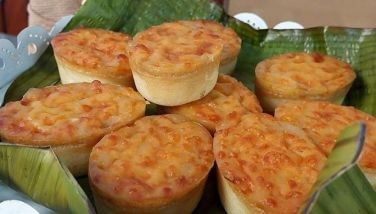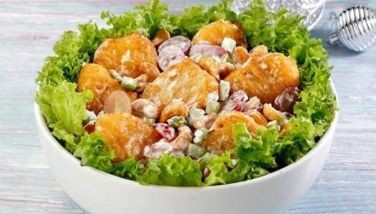Childhood treats and the Iloilo Tabu-an festival
Growing up, most of our helpers at home were almost always kamag-anaks or relatives of another long-time helper of my abuelita, or of the family. They often stayed with us for years — one who is still with our family has been with us for over 30 years.
As the youngest child (by 13 years’ difference!), I was often home alone afternoons hanging out with our helpers. I would wash my dolls’ clothes while they would make labada, I would make them kulit in their kitchen, preferred to take my naps in their room than in mine.
They were also almost all from the Ilonggo region. I would call them affectionately “’day,†short for “inday,†and my Filipino was a gibberish hybrid mix of Tagalog and Ilonggo. “’Day, saan na ang pagkaon ko, please?†Pomelo was kabugaw and when I was being naughty, “Ambot sa imo, ka gamu ka man gid†was the standard reaction. When one of them would go on their long vacations, I would look forward to their pasalubongs consisting of traditional sweets: biscocho, bañadas, piaya and my favorite, pinasugbo. I would sit at the edge of the sidewalk, gnawing away at the sticky, hard, caramelized banana slices. Eating one piece required full concentration, as you tried not to get too many stuck on your teeth. Then, once you reached the folded paper, you’d have to focus a little more. I would meticulously peel off what I could, but no matter what I did and how hard I tried, there were always a few bits stuck to the caramel. I’d shrug it off and eat it anyway and the food memory of these banana treats are closely linked to that contrasting taste of bland, ashy paper against the semi-bittersweet sugary coating. It’s not pinasugbo without it. But more than the memory of their treats was the fact that Visayans are some of the warmest people I know. They are hardworking, caring, wholeheartedly generous and have the biggest and most inviting smiles. And they love to eat.
Last week I was invited to participate as a judge in the Tabu-an Annual Western Visayas Ilonggo Heritage Cooking Competition and Food Fair, and for my first time in Iloilo, I really felt right at home. From the jubilant welcome chef Tibong (more formally, chef Raphael Jardeleza) gave us at the airport, stating that our itinerary for the day revolved around the hours of our meals (lunch at 10:30? Why not?); to the enlightening and heartwarming conversation I had with our driver as he dropped sleepy, preggy me home early one evening; to the truly honest smile the doorman of our hotel, Amigo Terrace Hotel, flashed me at 4:30 on a Sunday morning when I was airport-bound. “Happy trip, ma’am! Ingat po kayo.†And you could tell he really meant it. Maybe it was the way the language is so familiar, or that every old lady reminded me of the manangs in my grandmother’s house, and that even some of the elderly mestiza gentry also reminded me of my abuelita herself and her friends, with their curled short hair and comforting smiles. Or that everything we ate was cooked from the heart.
A historic palate
Amid the haphazard mid-century buildings bearing charming vintage signs and the strikingly modern, clean-lined developments, Iloilo City has wonderful pockets of history and heritage. Family homes in the old colonial turn-of-the-century style, art deco gems and stunning churches.
Molo is one of the seven districts of the city and home to quite a few famous eats. The Parish of St. Anne, once referred to by Jose Rizal as “La Iglesia Bonita,†is not only breathtaking for its vaulted architecture but a key proponent in the creation of some iconic local delicacies. The Panaderia de Molo has been around since the late 19th century. Back when the church was being built, masons used egg whites to hold the bricks together like cement, leaving an abundance of egg yolks. So as not to let them go to waste, using recipes of Spanish influence, they were turned into our favorite sugary treats. Perhaps even more famous is the iconic molo soup. The Molo district was originally home to Chinese immigrants, bringing their wonton soups along with them. We went to the home of Kap Ising’s pancit molo, a rich, clear broth made from pork bones, tiny dried shrimp hibe, and a smidgen of salty tofu seasoned with white pepper and kutsay leaves. The wontons are stuffed with a juicy, flavorful homemade filling that bursts into comforting goodness in your mouth. Their shape is reminiscent of the convent nuns’ white hats when raw, turning into slippery silken sheets once cooked. Sitting there in that small courtyard, in the quiet of the late morning, inhaling the fragrant steam, I couldn’t have felt more at ease, more at home.
Progressive quality
Iloilo is not only about tradition. One can feel the vibrant energy of the city as soon as you land. The economy seems to be growing; things are moving and changing in the right direction. The mayor, Jed Patrick E. Mabilog, explained to us that their new city hall building was constructed to be eco-friendly, with solar panels to power their aircons and a system to recycle water.
The food scene is no different, with restaurants like Markims, owned by Tin Tin Ke, the nephew of Roberto’s famous siopao owner Claude Yap. Markims offers tasty Asian-Filipino dishes and has some of the best barbecue I’ve ever had. Contrary to the usual chewy pork BBQ sticks, these were perfectly marinated, soft and tender, molded thinly onto the bamboo for smaller but more succulent bites.
Another favorite local haunt is Breakthrough, which offers the freshest ingredients cooked on the spot to perfection. You cannot miss out on their local managat fish. Firm, rich and cloudlike, just grilled and perfect to have with your own special blend of dipping sauces, including their gorgeous, lip-smacking sinamak vinegar so full of langkawas or blue ginger, chili and garlic that the bottle is mostly chopped ingredients than vinegar. The owner, Raymundo Robles, is a marine biologist who wanted to open a food business on the side, but the tanks of the swimmingly fresh fish and clams are a testament to quality. He is one of the main supporters of that wonderful managat fish.
Of pride and heritage
Despite all our food tripping, the main reason we were there was, of course, for the Tabu-an festival. In this day and age of fast and practical cooking, where many contests are sponsored by quick-fix ingredients and almost everything comes from a powder or a can, it’s a true pleasure to witness the making of things from scratch, the old-fashioned way.
The seven teams came from all over Iloilo as well as Roxas City, Bacolod and Kalibo. Despite the recent devastating events, they came to show their fighting spirit through their passions. Each team had to prepare an appetizer, a main and a dessert using only the most traditional ingredients and techniques.
It was truly a feast for the senses, with mountains of fresh vegetables, leafy greens like roselle leaves or labog that I’ve never even heard of, giant pots of steaming juicy clams, heavy serious-looking mortars and pestles (lusong and hal-o) made of stone and solid wood. The results for me were truly a learning experience. Vibrant flavors made from forgotten ingredients, inspiring youth reminiscing about how their lolas would cook, toothy-grinned manangs working deftly and matter-of-factly.
While I may not have been the best choice as a judge compared to my more knowledgeable colleagues in terms of local food history (I could only judge based on general international aspects of cooking), I was above all honored to be there. To simply absorb what was going on around me, to fill my soul through my belly with centuries of history and culture, to warm my heart with soups made with love and to ingest laughter through an abundance of sweets.
As chef Tibong stated in his speech during the awards ceremony, “…to understand who we are, where we came from by understanding what we eat.†Between the indigenous ingredients and the Chinese and Spanish legacies, a visit to Iloilo is a must for every Filipino. To complete yourself with each and every bite. If you are what you eat, then definitely I came away from this trip declaring “I am Iloilo.â€
* * *
Amigo Terrace Hotel – http://amigoterracehotel.com
Panaderia de Molo – Lopez Jaena Street, Molo, Iloilo City, 033-320-3878
Kap Ising’s Pancit Molo – Barangay South San Jose,
Molo, Iloilo City, mobile: 0920-675-8794, tel:
O33-336-6106
Breakthrough Restaurant – Villa Beach, Barangay Sto. Niño Sur, Arevalo, Iloilo, Philippines, tel: 033-337-3027
Markims My Kitchen – Diversion Road, Iloilo, 033-396-0577, 033-320-3188
- Latest
- Trending























